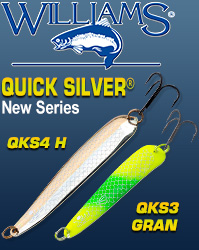DNR Stream bank program moves into NE Wisconsin
GREEN BAY - Anglers, conservationists and landowners with stream-front
property are invited to an informational meeting from 6 to 9 p.m. Thursday,
Aug. 27, at the Wittenberg Community Center about opportunities available
through Wisconsin's Stream Bank Protection program
<http://dnr.wi.gov/topic/fishing/streambank/> .
The program - which involves the purchase of conservation easements -
provides for public fishing access to high-quality trout and smallmouth bass
streams and fosters "stream rehabilitation" projects to improve fish habitat
and water quality.
At the meeting, staff from the Department of Natural Resources will seek
feedback from the public on proposed additions to the stream-bank
eligibility list, specifically streams in the northeast region of the state
and primarily in a focus area that includes a large part of Shawano County
and neighboring portions of Marathon, Portage, Waupaca, Lincoln and Langlade
counties.
DNR staff also will provide general information on the Streambank Protection
Program, which since its inception in 1989 has proven itself to be popular
with both anglers and landowners.
Under the program, DNR uses funds from the Knowles-Nelson Stewardship
Program to purchase stream-bank easements from willing landowners. Each
easement conveys the right of public access and the right to manage
vegetation within a 66-foot corridor on each side of the stream.
Land values for each stream parcel are calculated by real estate appraisers
and the easement rights are perpetual. Hunting and trapping rights are not
included within stream bank easements and remain under landowner control.
The DNR has used easements for decades to provide anglers with access and to
engage in stream improvements on private property. Fisheries biologists work
closely with a wide range of conservation groups throughout Wisconsin to
assist in these efforts.
"A local team approach involving partnerships with Trout Unlimited,
conservation clubs, land trusts, local landowner advocates and county land
conservationists will be critical to the success of the program as it moves
into northeast Wisconsin," said DNR fisheries biologist Jonathan Pyatskowit.
Trout Unlimited chapters in Wisconsin TU's central and northeastern regions
are already sharply focused on this new initiative, said Tom Lager,
president of TU's Fox Valley Chapter.
"We want to partner with whoever we need to help make this happen," Lager
said. "This is one of the key things we are going to be focused on for years
to come. The Stewardship funding will pay for easements. We will be
providing funds and labor to help implement the program."
While the stream bank protection program in northeast Wisconsin will be
modeled on the successful program in the southwest, it will also recognize
important differences in the region's geology, topography, vegetation,
history and culture.
"A lot of these streams have seen the historic impacts of logging," Lager
said. "Some are shallow and wide, and their substrate is not as conducive to
trout spawning."
Revitalized streams improve property values, Lager said. TU members are
willing to help sell the program and to work with landowners, to showcase
work on central Wisconsin streams, with stabilized banks and narrower,
deeper and swifter channels of clean, cold water.
While such work is a key part of the program, Pyatskowit said, the purchase
of a stream bank easement does not mean habitat work will occur in every
case. In many instances, it will simply mean the landowners receives a
financial benefit, trout fishermen gain access to the stream and DNR
biologists join the landowner in protecting the 66-foot riparian zone on
either side of the stream.
"Overall, the trout streams are doing fine," Pyatskowit said. "Most of the
stretches we've picked for inclusion are Class 1 trout streams that support
natural reproduction. In many cases, the main goal is to keep it that way."
At the Aug. 27 meeting in Wittenberg, participants will help biologists
determine which stretches of which streams should be priorities for the
program. The community center is in village offices at 208 W. Vinal St. in
Wittenberg.
For application materials and more information about the program, interested
individuals can search the DNR website dnr.wi.gov <http://dnr.wi.gov/> for
keyword "streambank <http://dnr.wi.gov/topic/fishing/streambank/> ." DNR
staff is working on an update to this page, which should be ready in advance
of the informational meeting.
Interested landowners can contact their local fisheries biologist for more
information. A list of biologists across the state who are able to assist
landowners with stream bank easements can be found online at
http://dnr.wi.gov/files/pdf/news/sbp_statewide_contacts.pdf









